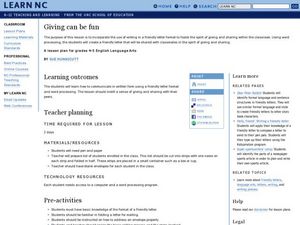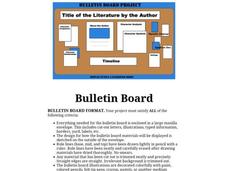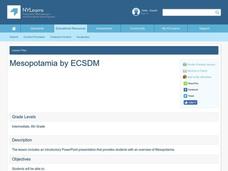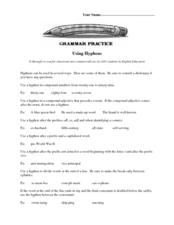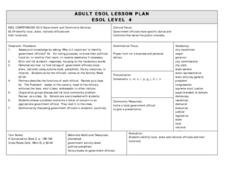Curated OER
ABC and 1-2-3 Farming
Students demonstrate how to alphabetize animal names. In this word study lesson, students identify animals that live on the farm and conduct a favorite farm animal survey. Students order animal pictures in alphabetical order.
Curated OER
Star Wars: Rays and Angles Edition
Rays and angles and Star Wars? It sounds strange, but it's actually a fun game to help fourth graders get good at measuring and identifying angles and rays with a protractor. Each pair of children chooses which Star Wars character they'd...
Curated OER
The True Cost of Coffee
Students examine the economic, health and environmental risks of being a one-crop country. They explain the risks of relying on one crop. They also identify the factors that resist change.
Curated OER
Giving Can Be Fun!
That it is better to give than receive can be a difficult concept for little ones, especially during the Christmas holiday season. A reading of Jan Brett’s, Christmas Trolls, helps children focus their attention away from what they want...
Curated OER
Graphing Ordered Pairs
Are you working on graphing ordered pairs in your class? For this worksheet, learners, after looking over and studying how to graph ordered pairs, plot points on a coordinate grid and connect the dots. Class members also identify what...
Sandra Effinger
Bulletin Board Project
Imagine a project that informs and entertains. Replace book reports with a bulletin board that highlights all the important elements of a novel. Readers research the author, create a timeline of events in the story, write a...
Curated OER
Mesopotamia
Sixth graders describe the geography of Mesopotamia, explain the characteristics of Sumerian city-states, and identify the cultural practices of the ancient Sumerians. They then explain how empires formed in Mesopotamia.
Curated OER
The Bill of Rights: Debating the Amendments
Provide your class with an opportunity to investigate an important historical document. Without identifying the document, distribute copies of the original Bill of Rights, as transcribed by John Beckley, Clerk of the House of...
Curated OER
Using Hyphens
Teaching grammar can be so difficult! Help your class master how to use hyphens correctly. The first page details different places one would use a hyphen. On the second page, learners are introduced to two practice activities. In the...
K12 Reader
The Important Apostrophe: Their, They’re, and There
They're going to be there with their family. Class members practice using and identifying the correct use of they're, there, and their with a skills practice worksheet. The top half of the worksheet gives brief background information on...
K12 Reader
The Important Apostrophe: You're and Your
You're going to love a worksheet that teaches your class the difference between you're and your. Learners read a brief introduction explaining the two words and practice identifying the correct uses. Then, they read sentences...
Curated OER
Let Us Rhyme With Madeline
Listen to the book Madeline, and identify rhyming words with learners as they hear them in the book. Learners will engage in a class discussion about rhyming words. After listening to Madeline, they will circle pictures of words that...
Houghton Mifflin Harcourt
Special Friends: English Language Development Lessons (Theme 9)
Enhance language proficiency with a Special Friends themed English language development unit. Each lesson follows a listen, speak, move, and/or look routine that is guaranteed to get your scholars discussing topics such as animal...
Read Works
How to Say “I Ruff You”
Who says you need a human to be your valentine on Valentine's Day? Give your dog-loving readers an inspiring perspective on how a sister givdes her brother a valentine from the family dog. They then answer 10 questions thatd involve...
Florida Center for Reading Research
Phonological Awareness: Rhyme, Rhyme or No Rhyme
Rhyming is fun, builds phonemic awareness, and is a tried and true pre-reading skill. This activity helps learners identify words that rhyme. Young scholars listen to a song, locate a rhyming word they hear by clapping then draw a...
Curated OER
SOAPS Primary Source "Think" Sheet
Planning on using primary source materials? Introduce your class members to SOAPS, a learning exercise that models how to analyze and reflect on primary source materials. Readers name the document, identify the subject (S), the...
K12 Reader
Jabberwocky
Readers demonstrate their ability to use word endings and word relationships to identify the parts of speech of the nonsense words in Lewis Carroll's "Jabberwocky."
Reading Resource
/er/ Word List
As part of a phonemic awareness exercise, kids identify and highlight the /er/ sound in a list of 59 words and then read these words to an adult. The activity is the sixth in a series of 16 resources designed to develop the...
Homeschool Creations
Caps for Sale Printables
Caps for sale! Get your class into some monkey business with a fun set of activities based on Esphyr Slobodkina's Caps for Sale. Pupils practice tracing lines between caps and monkeys, identify colors of caps,...
Talking with Trees
What is Respect?
Inspire scholars to be the best they can be with a learning exercise featuring the character trait, respect. Individuals read multiple scenarios, match their outcomes, and identify whether the behavior was respectful or...
Curated OER
The "B" Box
Young scholars complete a variety of activities related to the letter B and the /b/ sound. As a class they recite a tongue twister, and identify objects from a box that have the /b/ sound in their name. Students also listen to the...
Curated OER
Slithering "S"
Students identify the grapheme and phoneme for S. They practice writing the letter S and through listening activities, discriminate the phoneme /s/. They associate the phoneme /s/ with its letter representation and identify it as the...
Curated OER
Snake Talk
Students identify the grapheme and phoneme for S. They practice writing the letter S and through listening activities, discriminate the phoneme /s/. They associate the phoneme /s/ with its letter representation and identify it in various...
Curated OER
Dear Congressperson...
Young scholars identify their local, state, and national officials. They create a short blurb about each official and their function in office. Students choose an issue of concern they would like to write to their local official about,...



